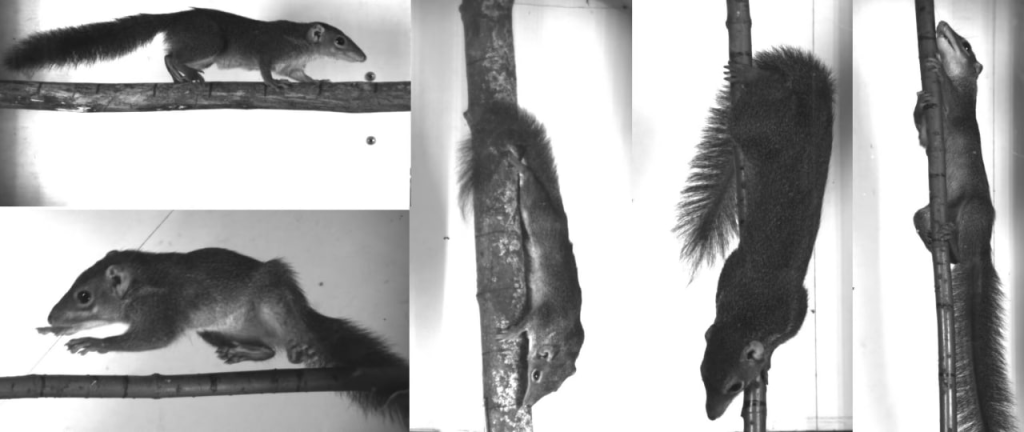
An international team of scientists has found that the Malayan tupaya uses the same motor patterns as primates when moving through trees. This shows that some of the characteristics of primates appeared in evolution before themselves. The work was attended by scientists of the A.N. Severtsov Institute of Ecology and Evolution (IEE) RAS.
One of the most interesting mysteries in human evolution is the transition to the arboreal lifestyle of its ancestors, the primates. Most of them, including the most primitive representatives, are arboreal animals. According to one theory, it is assumed that human upright posture arose as a result of the adaptation of his closest ancestors to one of the most specialized ways of arboreal movement - brachiation.
During brachiation, the animal moves by hanging under the branches of trees and throwing itself from branch to branch with its forelimbs (arms). This method is well suited for the movement of relatively large animals in crowns with horizontal branches. Gibbons, orangutans, and some South American monkeys are capable of brachiation.
Today, the brachiation hypothesis has become one of the main reconstructions of the formation of human upright posture, since the body is located vertically, and the musculoskeletal system adapts to this position.
However, the question of how exactly the primates mastered the arboreal way of life, and how their early locomotor adaptations were formed, remains open. Their next of kin can help answer it.
Tupai are small semi-arboreal animals, genetically the closest relatives of primates. They live mainly on the ground, but some of their species deftly move in the crowns of trees. For scientists, the tupai is the best "live" model of a primate ancestor. In order to study their ability to move on branches, an international team of researchers surveyed the Malayan tupaya (Tupaia belangeri) at the Moscow Zoo.
It was originally assumed that the tupai used a "squirrel-like" way of moving along the branches. Squirrels are rodents that have perfectly mastered the three-dimensional locomotor environment of tree crowns. However, their arboreal specializations arose and developed quite independently of primates, and the initial stage was terrestrial rodents, reminiscent of modern marmots or ground squirrels.
The gaits (order of rearrangement of legs) used by arboreal rodents differ from those of primitive primates on branches. Thus, it was expected that a detailed study would be able to find more similarities in the movement along the branches in the tupai and primates than between rodents and tupai.
The study of the Malay tupaya made it possible to significantly supplement the ideas about the technique of their movement (gaits and the way of grabbing branches with their paws), as well as to analyze the similarities and differences in the locomotion of these animals with primitive primates (using the example of the fat-tailed lemur).
In the experiment, the tupai willingly climbed the branches, using predominantly quadrupedal climbing and jumping. The quadrupedal climbing sequence of the tupaya was similar to that of the fat-tailed lemur (Cheirogaleus medius), a primitive primate of the same size.
In addition, the animals developed a grasping mechanism similar to primates, in which the big toe of the hind leg is opposed to the rest of the fingers, and as a result, the paw covers the branch from two sides. An analysis of the surveys showed that the tupai have primitive locomotor characteristics of mammals and more specific features that are characteristic of lower primates.
“The study suggests that a number of locomotion patterns that were thought to be unique to primates actually characterize a broader group of mammals called Euarchonta, which, in addition to primates, also includes tupai and colugos,” said Alexandra Panyutina, senior researcher at IEE RAS.
The fact that tupai and primates share specialized locomotion traits that are not found in other placental mammals suggests that they had a common ancestor. This means that thumb opposition in walking is not unique to primates, as previously thought. Moreover, everything indicates that this trait arose earlier, even at the evolutionary stage of the common ancestor of the tupai and primates.
Researchers believe that the most primitive primates already possessed both this specialization and its characteristic morphology (the science of the shape and structure of the body), which can be confirmed in the future by paleontological data. Further study of these animals will help to understand what morphological appearance the distant ancestors of humans had.
The study is published in the Journal of Experimental Zoology Part A.
Related materials:
TASS Nauka: "The opposition of the thumb in primates was not unique"
MK.ru: "Russian scientists have found the predecessor of monkeys"
